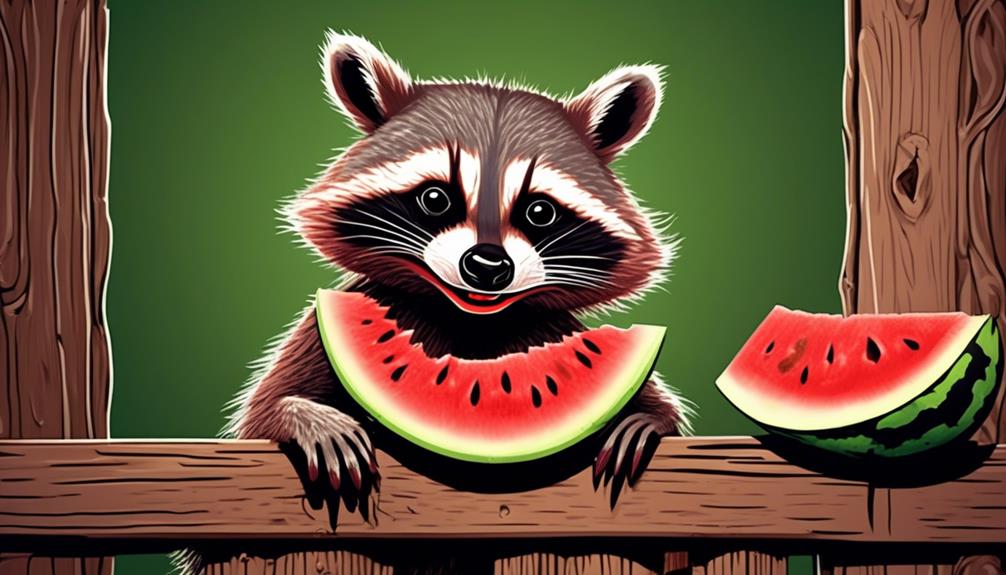Imagine a warm summer day, the sun shining brightly overhead as you bite into a juicy slice of watermelon, the sweet juices dribbling down your chin.
Now, have you ever wondered if raccoons share the same love for this refreshing fruit? Well, you’re in for a treat! In this discussion, we will uncover the truth about raccoons and their relationship with watermelons.
Prepare to be surprised as we unravel the mysteries of these clever creatures and their potential affinity for this delectable treat. So, let’s dive into the world of raccoons and watermelons, and discover whether these masked bandits have a taste for this summertime delight.
Feeding Watermelons to Baby Raccoons
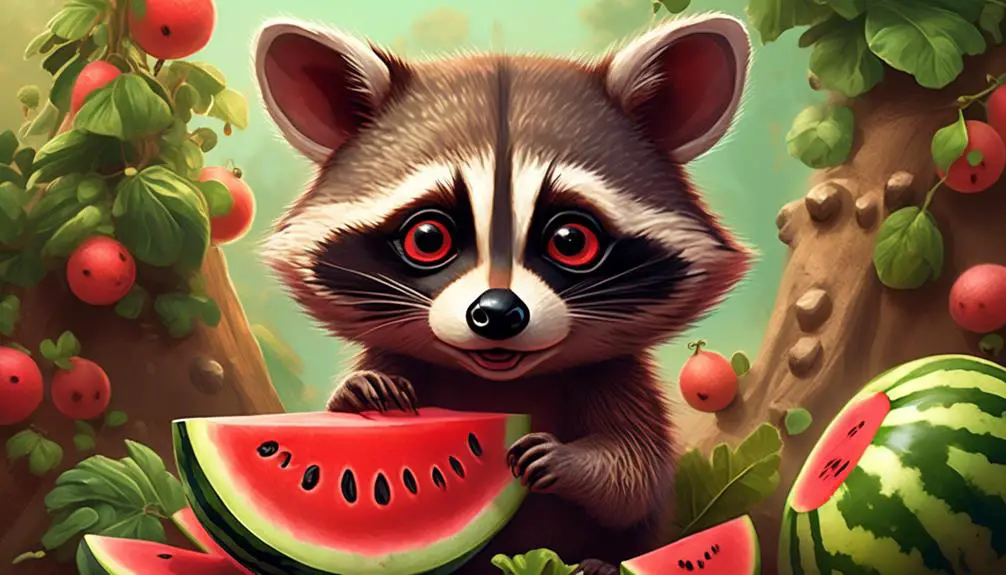
Feeding watermelons to baby raccoons is a suitable option as long as the seeds are removed to prevent choking and the fruit is mashed for easy digestion. Watermelons can provide a nutritious addition to the diet of baby raccoons. When feeding watermelons to baby raccoons, it’s important to consider their small size and delicate digestive systems.
The seeds in watermelons can pose a choking hazard for baby raccoons. Therefore, it’s crucial to remove the seeds before feeding them the fruit. Additionally, mashing the watermelon can aid in easy digestion for the raccoons. This is because their digestive systems aren’t fully developed, and mashing the fruit can make it easier for them to break down and absorb the nutrients.
Watermelons are rich in vitamins and minerals, such as vitamin C and potassium, which are beneficial for the growth and development of baby raccoons. However, it’s important to note that watermelons shouldn’t be the sole source of nutrition for these animals. A balanced diet that includes a variety of foods is essential to ensure their overall health and well-being.
Wild Raccoons and Watermelons
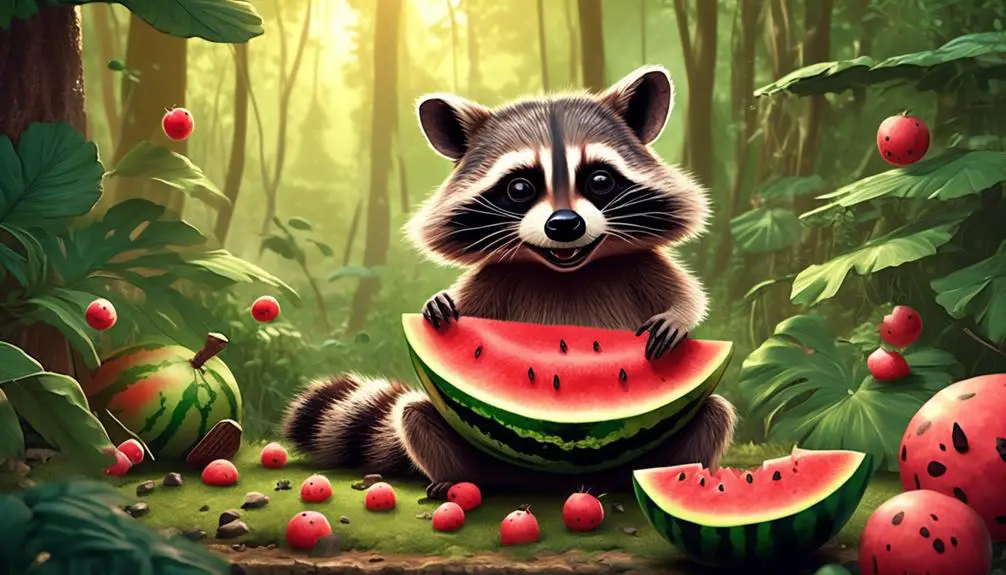
Wild raccoons have a diverse diet that primarily consists of animal-based food such as fish, crawfish, snails, and snakes. However, when suitable animal-based food is scarce, they may turn to plant-based food sources.
While wild raccoons don’t typically eat watermelons, they may be attracted to commercial watermelons with more flesh and bore holes to consume the flesh, especially if other food sources are limited.
Wild Raccoon Diet
Raccoons in their natural habitat typically have a varied diet consisting of animal-based food and, when resources are scarce, plant-based options, although watermelons aren’t a common part of their diet.
In the wild, raccoons show a preference for animal-based food such as fish, crawfish, snails, and snakes. However, they’ll consume plant-based food when suitable animal-based food is scarce.
While wild raccoons usually don’t eat watermelons, they may be attracted to commercial watermelons with more flesh. In some cases, raccoons may bore holes in wild watermelons and eat the flesh.
It’s important to note that raccoons are opportunistic feeders and can consume watermelon rinds if hungry. However, their preference lies in the fruit’s flesh rather than the rinds.
Plant-Based Food Preference
Do wild raccoons have a preference for plant-based food, such as watermelons? While wild raccoons primarily prefer animal-based food like fish, crawfish, snails, and snakes, they will consume plant-based food when suitable animal-based options are scarce. The table below provides an overview of wild raccoons’ food preferences and behaviors regarding watermelons:
| Wild Raccoons and Watermelons | |
|---|---|
| Preference for Animal-Based Food | Fish, crawfish, snails, and snakes |
| Consumption of Plant-Based Food | When suitable animal-based food is scarce |
| Attractiveness of Commercial Watermelons | Raccoons may bore holes in wild watermelons and eat the flesh |
| Typical Behavior | Wild raccoons usually do not eat watermelons |
| Raccoon and Watermelon Rinds | Raccoons can consume watermelon rinds if hungry |
| Scavenging and Opportunistic Feeding | Improper disposal of watermelon rinds can attract raccoons |
Attraction to Commercial Watermelons
Commercial watermelons are often found to be attractive to raccoons, who may bore holes in them and consume the flesh. Wild raccoons typically prefer animal-based food such as fish, crawfish, snails, and snakes. However, when suitable animal-based food is scarce, they may resort to consuming plant-based food.
Commercial watermelons, with their abundance of flesh, can be appealing to raccoons in such situations. While wild raccoons usually don’t eat watermelons, they may occasionally bore holes in the fruit and consume the flesh. Raccoons are opportunistic feeders and will take advantage of available food sources.
Therefore, it’s important to properly dispose of watermelon rinds to avoid attracting raccoons. In captivity, watermelons can provide nutrition, including vitamins and minerals, and are sometimes given as snacks to captive raccoons. Whole watermelons can also serve as attractive playthings for raccoons in zoos, drawing them out of hiding.
Raccoons Eating Watermelon Rinds
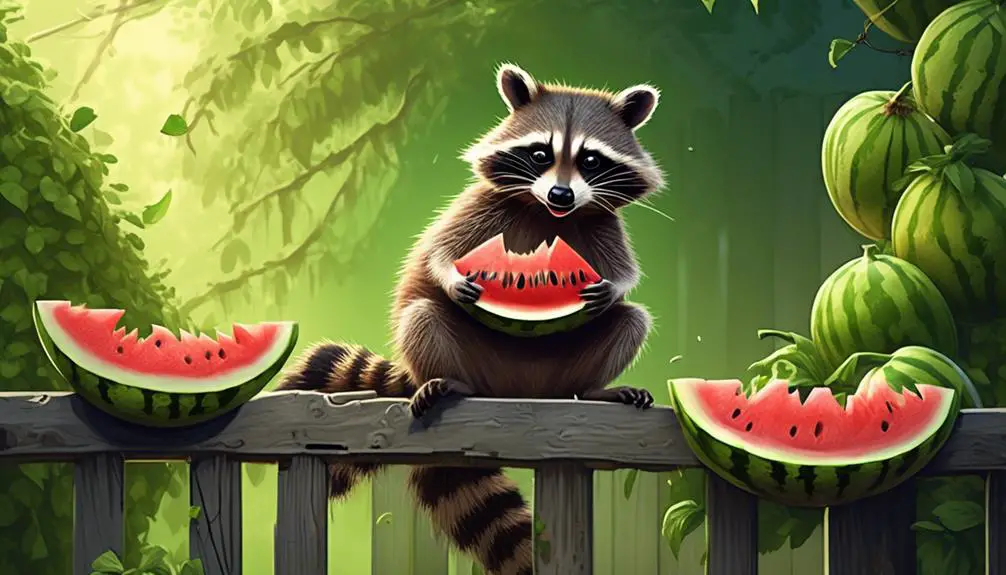
Watermelon rinds can be consumed by raccoons if they’re hungry enough and have no other food options available. Raccoons, known for their highly developed sense of touch, typically prefer the flesh of the fruit but can resort to eating the rinds when necessary.
As scavengers and opportunistic feeders, raccoons adapt their diet based on availability. While wild raccoons typically prioritize animal-based food such as fish, crawfish, snails, and snakes, they’ll consume plant-based food when suitable animal-based options are scarce.
It’s worth noting that raccoons are less likely to eat watermelons in the wild, but commercial watermelons with more flesh can attract their attention. Improper disposal of watermelon rinds can also draw raccoons due to their scavenging nature.
In captivity, watermelons are occasionally given to raccoons as snacks, providing them with essential nutrition like vitamins and minerals. However, it’s crucial to monitor the amount of watermelon provided due to its vitamin C content.
Whether in the wild or in captivity, raccoons’ dietary needs should always be properly monitored and met to ensure their health and well-being.
Feeding Watermelons to Captive Raccoons
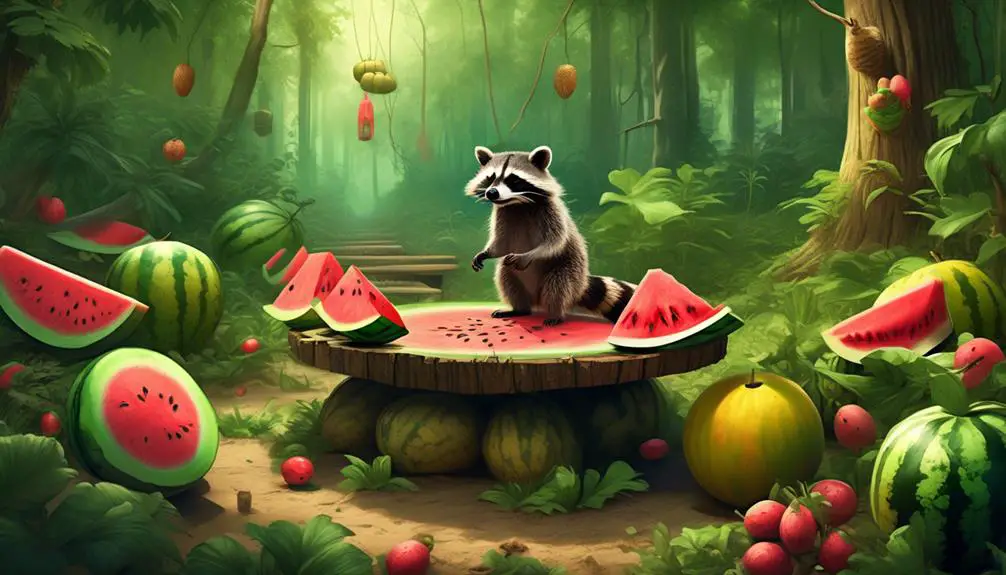
When feeding watermelons to captive raccoons, it’s important to consider their controlled diets. Watermelons can be given as occasional snacks, providing nutrition in the form of vitamins and minerals.
However, it’s crucial to monitor the amount of watermelon given due to its high vitamin C content. Proper diet monitoring is necessary to ensure the well-being of captive raccoons.
Controlled Diets for Captives
Captive raccoons are carefully monitored and provided with controlled diets, ensuring that their nutritional needs are met, including occasional snacks such as watermelons. Watermelons offer various vitamins and minerals that contribute to the overall health of captive raccoons. However, it is important to note that watermelons should be given in moderation due to their high vitamin C content. To provide a clear understanding of the controlled diets for captive raccoons, the following table outlines the recommended nutritional composition of their diets:
| Nutrient | Percentage |
|---|---|
| Protein | 25% |
| Fat | 40% |
| Carbohydrates | 35% |
This balanced diet ensures that captive raccoons receive the necessary nutrients for optimal health. Watermelons can be included as occasional treats, but their consumption should be monitored to maintain a well-rounded diet. By adhering to controlled diets, captive raccoons can thrive in their environment and remain healthy.
Monitoring Vitamin C Intake
To ensure the optimal health and well-being of captive raccoons, it’s crucial to carefully monitor their intake of vitamin C while incorporating watermelons into their controlled diets.
Watermelons can be a valuable source of nutrition for captive raccoons, providing essential vitamins and minerals. However, it’s important to note that watermelons aren’t particularly high in vitamin C compared to other fruits.
Therefore, while watermelons can be included as occasional snacks for captive raccoons, it’s necessary to monitor their overall vitamin C intake to prevent deficiencies. This can be achieved by supplementing their diet with other fruits that are rich in vitamin C, such as oranges or strawberries.
Regular monitoring and adjustment of the raccoons’ diet will help maintain their optimal health and ensure they receive adequate vitamin C levels.
Giving Whole Watermelons to Raccoons in Captivity
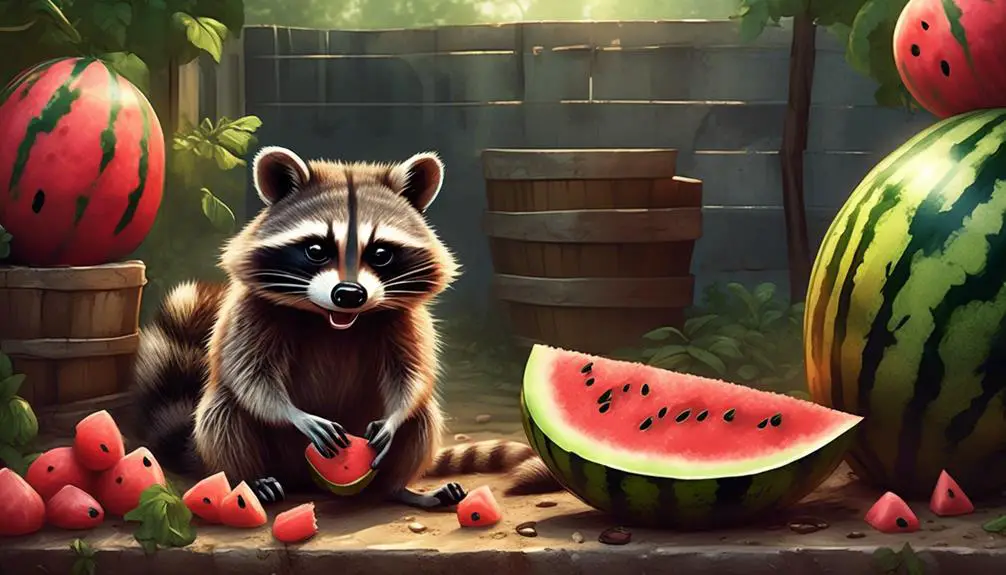
Whole watermelons are often given to raccoons in captivity as an enticing plaything and to encourage their curiosity. Raccoons in zoos and other captive settings are provided with whole watermelons to stimulate their natural foraging behavior and mental stimulation. The large size and vibrant colors of watermelons attract raccoons, making it an effective tool to draw them out of hiding.
When given whole watermelons, raccoons have been observed to use their sharp claws and teeth to bore holes into the fruit. This allows them to access the juicy flesh inside. Raccoons are known for their dexterity and resourcefulness, and they’ll often use their keen sense of touch to explore and manipulate objects, including whole watermelons.
While whole watermelons primarily serve as an engaging plaything for captive raccoons, they can also provide some nutritional benefits. Watermelons contain vitamins such as vitamin A and vitamin C, as well as minerals like potassium. However, it’s important to note that whole watermelons shouldn’t make up a significant portion of a raccoon’s diet. They should be offered as occasional snacks, rather than as a staple food source.
Baby Raccoons and Watermelon Seeds
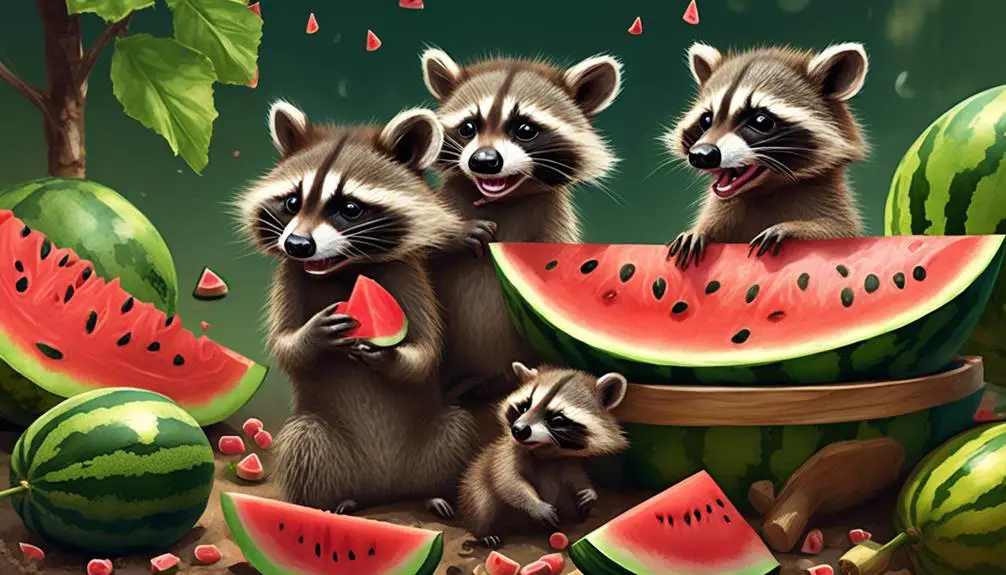
Baby raccoons can safely consume watermelons, but it is important to remove the seeds to prevent any potential choking hazards. Watermelon seeds are small and round, making them a potential risk for young raccoons who may not have fully developed their chewing abilities. By removing the seeds, you can ensure that your baby raccoon can enjoy the watermelon without any danger.
To emphasize the importance of seed removal, let’s take a look at the following table:
| Choking Hazard | Importance of Seed Removal | Ensuring Safety |
|---|---|---|
| High Risk | Remove seeds promptly | Crucial |
| Minimal | Monitor closely | Recommended |
| No Risk | Not necessary | Not needed |
As you can see, removing the seeds is crucial to prevent any potential choking hazards. It is always better to err on the side of caution when it comes to the safety of your baby raccoon.
In addition to removing the seeds, it is also recommended to mash the watermelon pieces for easy digestion. This will ensure that your baby raccoon can fully enjoy the watermelon while minimizing any potential digestive issues.
Mashing Watermelon for Easy Digestion
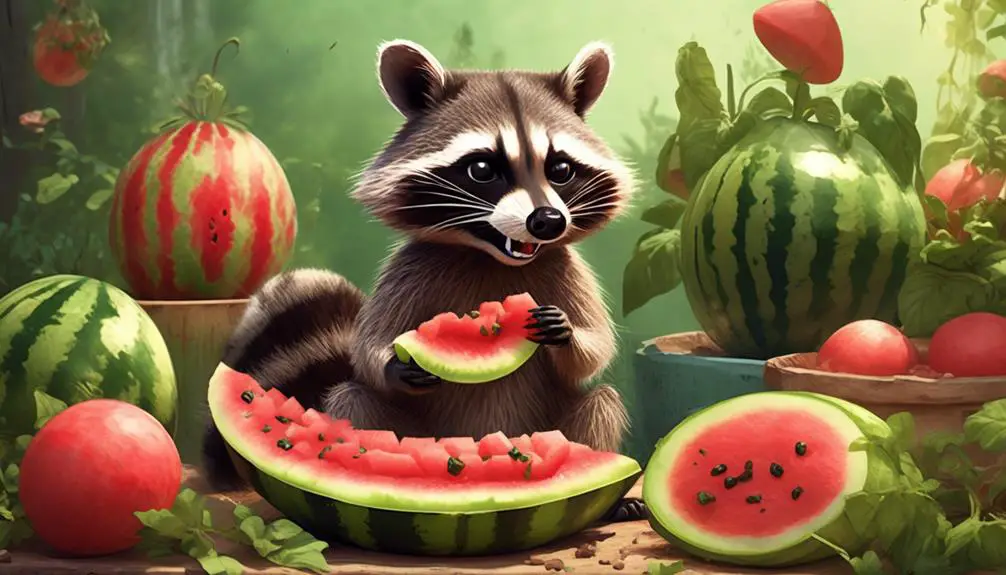
Mashing watermelon pieces is recommended for easy digestion in raccoons. Raccoons have a diverse diet, but they can consume watermelons if given the opportunity. Mashing the watermelon pieces helps break down the fruit’s fibers, making it easier for raccoons to digest. This is particularly important for baby raccoons, as their digestive systems are still developing.
When feeding watermelons to raccoons, it’s crucial to remove the seeds to prevent choking. Raccoons can eat the flesh of the watermelon, but the seeds can pose a hazard. Therefore, it’s best to mash the watermelon into smaller, manageable pieces. This not only aids in digestion but also reduces the risk of choking.
In addition to being easy to digest, watermelons provide essential nutrients for raccoons. They’re a good source of vitamins and minerals, which contribute to the overall health of the animals. However, it’s important to remember that watermelons should be given in moderation, as they’re high in sugar and water content.
Importance of Fresh Fruits for Pet Raccoons
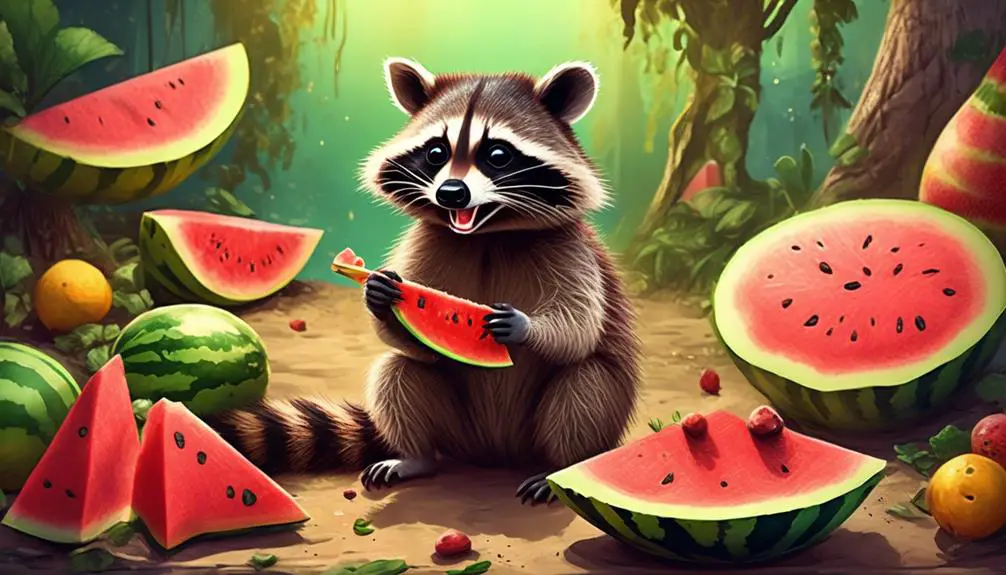
Fresh fruits play a vital role in providing essential nutrients for pet raccoons. While raccoons are omnivores and can consume a variety of foods, including meat and vegetables, incorporating fresh fruits into their diet is crucial for their overall health and well-being. Fruits are excellent sources of vitamins, minerals, antioxidants, and fiber, which are essential for maintaining proper bodily functions and preventing various diseases.
To emphasize the importance of fresh fruits for pet raccoons, let’s take a look at the following table:
| Nutrient | Role in Raccoon’s Health | Found in Fruits |
|---|---|---|
| Vitamin C | Boosts immune system and collagen production | Oranges, strawberries, kiwi, papaya |
| Vitamin A | Promotes good vision and healthy skin | Mango, cantaloupe, apricots, peaches |
| Potassium | Regulates blood pressure and heart function | Bananas, watermelon, honeydew melon |
Incorporating a variety of fruits into a raccoon’s diet ensures that they receive a well-rounded nutritional profile. However, it’s important to note that fruits should be given in moderation, as they also contain natural sugars. Consulting with a veterinarian or animal nutritionist can help determine the appropriate portion sizes and frequency of fruit consumption for pet raccoons.
Plant-Based Diet for Wild Raccoons
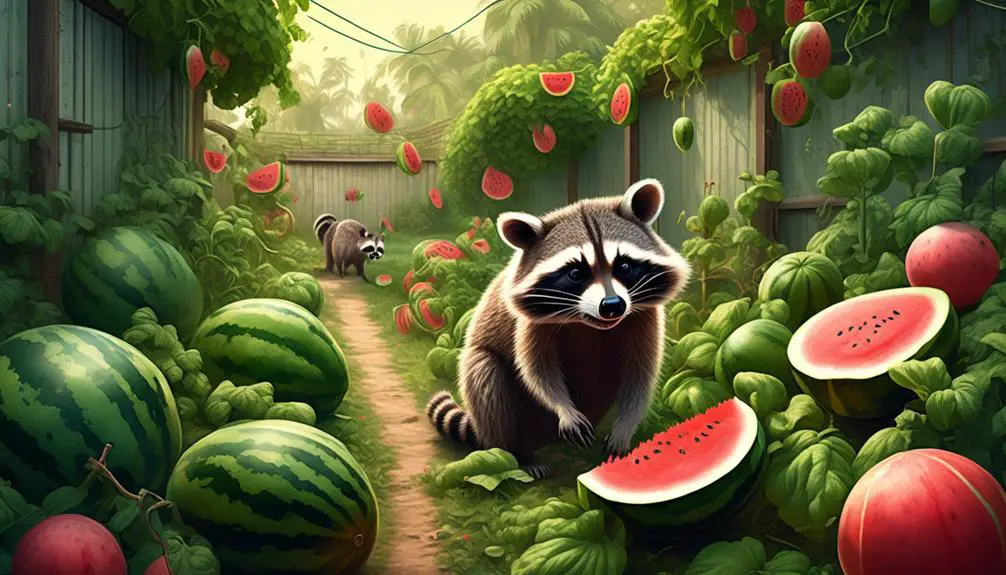
Wild raccoons have a diverse diet that includes both animal-based and plant-based food. When suitable animal-based food is scarce, raccoons will consume plant-based food to meet their nutritional needs.
Although they typically prefer fish, crawfish, snails, and snakes, raccoons may turn to plant-based options such as watermelons when animal-based food sources are limited.
Wild Raccoons and Plant-Based Food
Raccoons in the wild often incorporate plant-based food into their diet when suitable animal-based food is scarce. While wild raccoons primarily prefer fish, crawfish, snails, and snakes, they’ll consume plant-based food as an alternative source of sustenance.
Commercial watermelons with more flesh can be attractive to raccoons, who may bore holes in wild watermelons to access the sweet, juicy flesh. However, it’s important to note that wild raccoons usually don’t eat watermelons as a significant part of their diet. They’re opportunistic feeders and scavengers, so if hungry, raccoons may consume watermelon rinds. Raccoons have a highly developed sense of touch, enabling them to eat the rinds if necessary.
Improper disposal of watermelon rinds can attract raccoons, so it’s important to dispose of them properly to avoid unwanted encounters.
Raccoons and Food Scarcity
When faced with a scarcity of animal-based food sources, raccoons in the wild adapt their diet to incorporate plant-based alternatives. Wild raccoons are opportunistic feeders and will consume plant-based food when suitable animal-based options are limited. While they typically prefer fish, crawfish, snails, and snakes, raccoons may turn to plant-based food, such as watermelons, during times of food scarcity.
Commercial watermelons with more flesh are particularly attractive to raccoons, who may bore holes in wild watermelons and eat the flesh. Although wild raccoons usually don’t eat watermelons, they’ve a highly developed sense of touch and can consume the rinds if hungry. Proper disposal of watermelon rinds is important to avoid attracting raccoons, as they’re scavengers and will take advantage of available food sources.
In captivity, captive raccoons have controlled diets, and watermelons are occasionally given as snacks to provide nutrition. However, monitoring the amount of watermelon is crucial due to its high vitamin C content.
Attraction of Raccoons to Commercial Watermelons
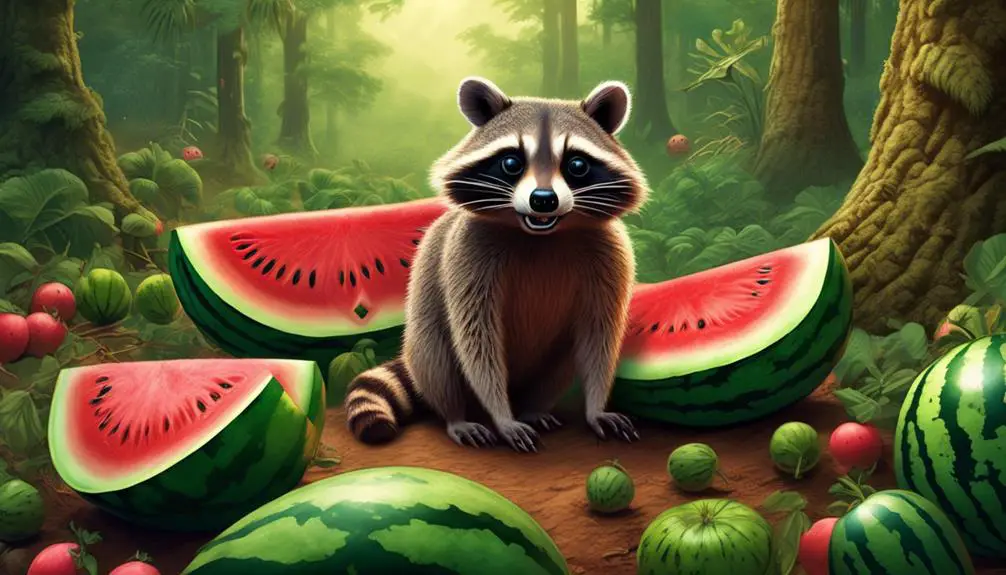
Commercial watermelons are often a tempting treat for raccoons due to their abundance of flesh and sweetness. Raccoons are opportunistic feeders, and when it comes to food, they’re attracted to the most abundant and easily accessible sources. Commercial watermelons, with their large size and juicy flesh, provide raccoons with a plentiful food source. These watermelons have been selectively bred to have more flesh, making them even more enticing to raccoons.
Raccoons have a highly developed sense of touch, allowing them to easily detect the ripeness and sweetness of watermelons. The sweet aroma emitted by the fruit acts as a strong attractant for raccoons, drawing them towards the watermelon patches. In some cases, raccoons may bore holes in the watermelons and consume the flesh directly from the fruit. This behavior is more commonly observed in wild raccoons, as they’ve to rely on available food sources in their natural habitat.
It is important to note that while raccoons are attracted to watermelons, they generally don’t rely solely on them as a food source. Raccoons are omnivorous creatures and have a diverse diet that includes both plant-based and animal-based foods. However, the abundance of flesh and sweetness found in commercial watermelons can make them an irresistible temptation for raccoons, especially when other food sources are scarce.
Raccoons’ Sense of Touch and Watermelon Rinds
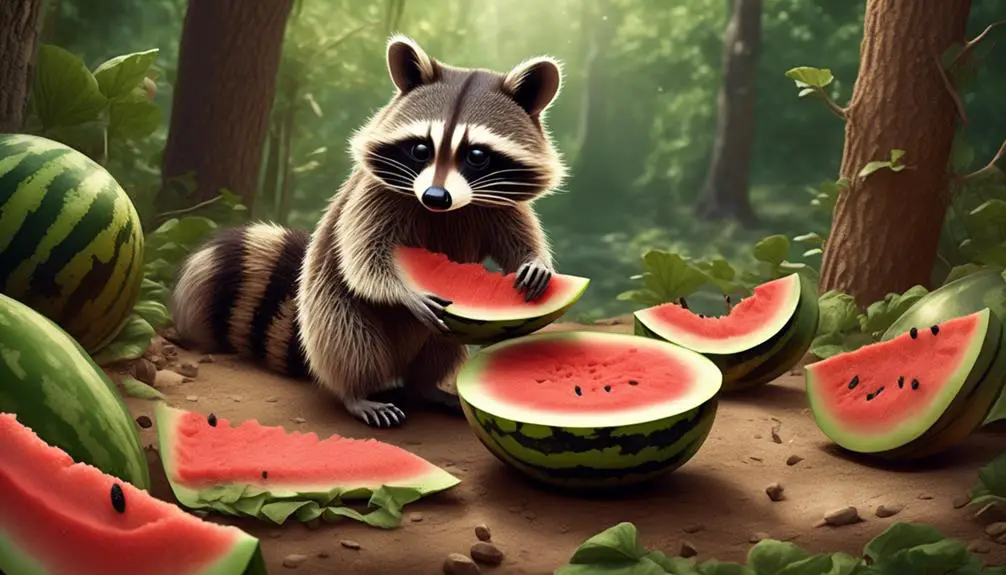
Raccoons have a highly developed sense of touch, which allows them to explore and interact with their environment. This sensitivity extends to their feeding behavior, as they can consume watermelon rinds if hungry.
While raccoons prefer the fruit’s flesh, they’re opportunistic feeders and will eat the rinds if necessary.
Proper disposal of watermelon rinds is important to avoid attracting raccoons to human areas.
Raccoons and Tactile Sensitivity
Watermelon rinds can be consumed by raccoons if they’re hungry, as raccoons have a highly developed sense of touch. Raccoons’ tactile sensitivity allows them to explore their environment and identify potential food sources.
When it comes to watermelons, raccoons primarily prefer the juicy flesh, but they can also eat the rinds if necessary. Raccoons are known to be scavengers and opportunistic feeders, adapting their diet based on availability. If other food sources are limited, raccoons may resort to consuming watermelon rinds.
It’s important to note that improper disposal of watermelon rinds can attract raccoons to human settlements, leading to potential conflicts. Understanding raccoons’ tactile sensitivity and their ability to consume watermelon rinds helps in managing interactions between raccoons and human populations.
Raccoons Eating Rinds
With their highly developed sense of touch, raccoons can consume watermelon rinds if they’re hungry and other food sources are limited. While raccoons generally prefer the flesh of the fruit, their opportunistic nature allows them to eat the rinds as well.
Raccoons are scavengers and adapt their diet based on availability. Their tactile sensitivity enables them to explore and manipulate objects, including watermelon rinds, in search of edible portions.
Improper disposal of watermelon rinds can attract raccoons to human habitats, as the remnants still contain traces of the fruit.
In captivity, watermelons are occasionally given to raccoons as snacks, providing nutrition in the form of vitamins and minerals. However, caution should be exercised with the amount of watermelon given, as it contains vitamin C, which can be excessive in large quantities.
Attracting Raccoons With Rinds
The highly developed sense of touch possessed by raccoons allows them to explore and manipulate objects, such as watermelon rinds, in search of edible portions. Raccoons are known for their ability to sense the texture, size, and shape of objects using their front paws, which are highly sensitive.
When encountering a watermelon rind, raccoons may use their nimble fingers to feel for any remaining flesh or juices. While their preference lies in consuming the fruit’s flesh, if hungry, raccoons can also eat the rinds. Raccoons are opportunistic feeders and scavengers, so improper disposal of watermelon rinds can attract them.
It’s important to properly dispose of watermelon rinds to avoid encouraging raccoons to forage in areas where they may come into conflict with humans.
Raccoons as Scavengers and Opportunistic Eaters
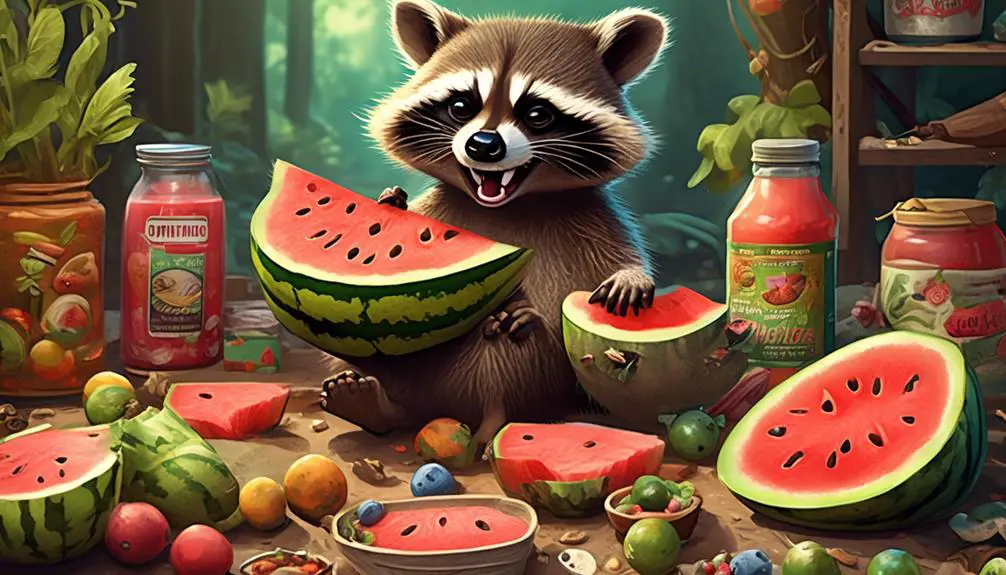
Raccoons, being highly adaptable scavengers and opportunistic eaters, have a diverse diet that includes both animal-based and plant-based food sources. They possess a remarkable ability to find food in various environments, allowing them to survive in urban areas as well as natural habitats.
In terms of animal-based food sources, raccoons primarily consume fish, crawfish, snails, and snakes. These protein-rich foods contribute to their overall nutrition and energy needs. However, when such animal-based food becomes scarce or unavailable, raccoons are capable of shifting their diet to include plant-based sources.
Raccoons exhibit a preference for plant-based foods such as fruits, nuts, berries, and vegetables. While they typically consume the flesh of fruits, raccoons can also consume watermelon rinds if they’re hungry enough. Their highly developed sense of touch enables them to extract nutrients from a variety of food sources.
It’s important to note that raccoons are scavengers and opportunistic feeders, which means they’ll exploit any available food source to meet their nutritional requirements.
Proper Disposal of Watermelon Rinds to Avoid Raccoon Attraction
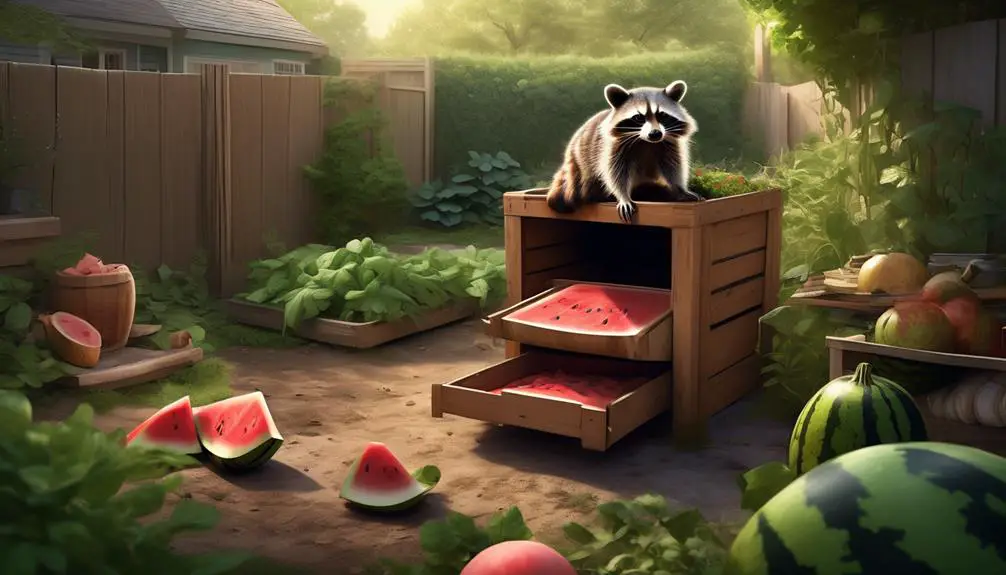
To prevent attracting raccoons, it’s important to dispose of watermelon rinds properly. Raccoons have a highly developed sense of touch and can consume watermelon rinds if they’re hungry. Although raccoons prefer the fruit’s flesh, they’re scavengers and opportunistic feeders, and will eat the rinds if necessary. Improper disposal of watermelon rinds can attract raccoons to your property, leading to potential problems such as damage to garbage cans or property, and the spread of diseases.
To properly dispose of watermelon rinds and avoid raccoon attraction, follow these guidelines.
First, place the watermelon rinds in a sealed plastic bag or container to contain the odor. This will prevent raccoons from detecting the scent and being drawn to the area.
Next, store the bag or container in a secure location, such as a locked shed or garage. This will further deter raccoons from accessing the rinds.
Finally, dispose of the watermelon rinds in a proper trash receptacle on the designated pickup day.
Monitoring Watermelon Intake for Captive Raccoons
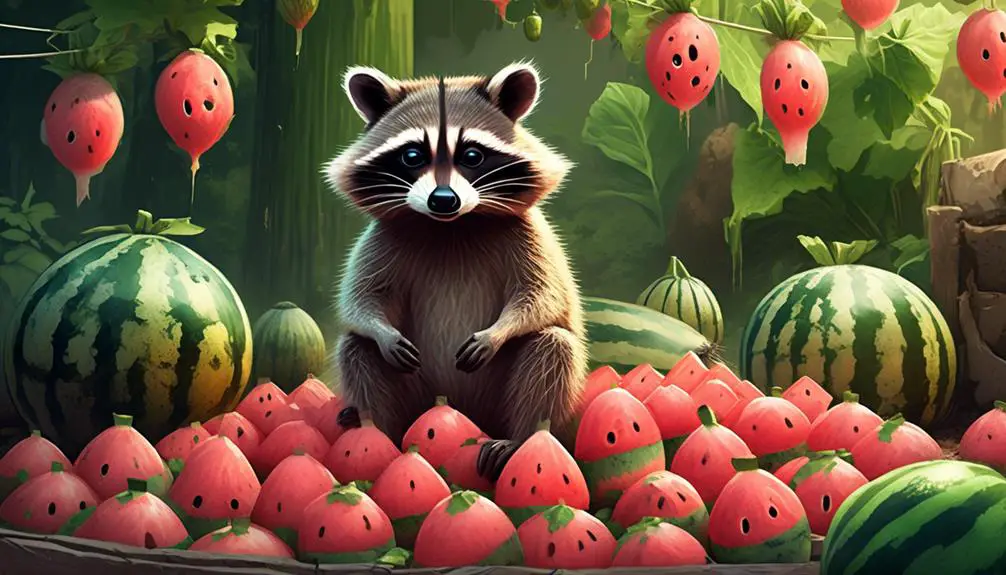
Properly monitoring the intake of watermelon for captive raccoons is essential to ensure their dietary needs are met in a controlled environment. Watermelons provide essential vitamins and minerals for raccoons in captivity, but excessive consumption can lead to health issues. Raccoons in captivity have controlled diets, and watermelons are occasionally given as snacks. However, it’s crucial to monitor the amount of watermelon provided due to its vitamin C content. While watermelons offer nutritional benefits, excessive vitamin C intake can cause diarrhea and gastrointestinal problems in raccoons.
To monitor watermelon intake, it’s recommended to offer small, controlled portions of watermelon to captive raccoons. This allows caretakers to observe the raccoons’ response and assess their tolerance to the fruit. Regular monitoring of the raccoons’ overall health and digestion is also important to ensure that watermelon consumption doesn’t lead to any adverse effects.
Additionally, it’s essential to consider the raccoons’ complete diet and not rely solely on watermelon as a source of nutrition. A balanced diet that includes a variety of foods such as meat, fruits, vegetables, and grains is necessary to meet all their nutritional requirements.

Erzsebet Frey (Eli Frey) is an ecologist and online entrepreneur with a Master of Science in Ecology from the University of Belgrade. Originally from Serbia, she has lived in Sri Lanka since 2017. Eli has worked internationally in countries like Oman, Brazil, Germany, and Sri Lanka. In 2018, she expanded into SEO and blogging, completing courses from UC Davis and Edinburgh. Eli has founded multiple websites focused on biology, ecology, environmental science, sustainable and simple living, and outdoor activities. She enjoys creating nature and simple living videos on YouTube and participates in speleology, diving, and hiking.

